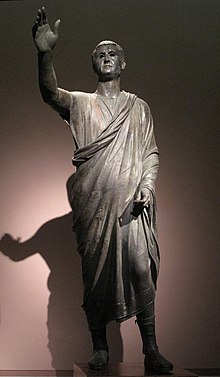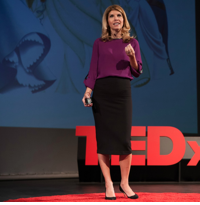The Roman orator Cicero speaks to the Roman Senate.
Cicero Denounces Catiline (1889), fresco by Cesare Maccari
Cicero Denounces Catiline (1889), fresco by Cesare Maccari
Public speaking (also called oratory or oration) is the process or act of performing a speech to a live audience. Public speaking is commonly understood as formal, face-to-face, speaking of a single person to a group of listeners.
However, due to the evolution of public speaking, it is modernly viewed
as any form of speaking (formally and informally) between an audience
and the speaker. Traditionally, public speaking was considered to be a
part of the art of persuasion. The act can accomplish particular
purposes including to inform, to persuade, and to entertain.
Additionally, differing methods, structures, and rules can be utilized
according to the speaking situation.
Public speaking was developed in Rome and Greece. Prominent
thinkers from these lands influenced the development and evolutionary
history of public speaking. Currently, technology continues to transform
the art of public speaking through newly available technology such as
videoconferencing, multimedia presentations, and other nontraditional
forms.
Uses
Public
speaking can serve the purpose of transmitting information, telling a
story, motivating people to act or encouraging people. This type of
speech is deliberately structured with three general purposes: to
inform, to persuade and to entertain. Knowing when public speaking is
most effective and how it is done properly are key to understanding the
importance of it.
Public speaking for business and commercial events is often done
by professionals. These speakers can be contracted independently,
through representation by a speakers bureau,
or by other means. Public speaking plays a large role in the
professional world. In fact, it is believed that 70 percent of all jobs
involve some form of public speaking.
History
Greece
The Orator, c. 100 BCE, an Etrusco-Roman bronze sculpture depicting Aule Metele (Latin: Aulus Metellus), an Etruscan man wearing a Roman toga while engaged in rhetoric; the statue features an inscription in the Etruscan alphabet.
Although there is evidence of public speech training in ancient Egypt, the first known piece on oratory, written over 2,000 years ago, came from ancient Greece. This work elaborated on principles drawn from the practices and experiences of ancient Greek orators. Aristotle
was one who first recorded the teachers of oratory to use definitive
rules and models. His emphasis on oratory led to oration becoming an
essential part of a liberal arts education during the Middle Ages and the Renaissance. The classical antiquity
works written by the ancient Greeks capture the ways they taught and
developed the art of public speaking thousands of years ago.
In classical Greece and Rome, rhetoric was the main component of composition
and speech delivery, both of which were critical skills for citizens to
use in public and private life. In ancient Greece, citizens spoke on
their own behalf rather than having professionals, like modern lawyers,
speak for them. Any citizen
who wished to succeed in court, in politics or in social life had to
learn techniques of public speaking. Rhetorical tools were first taught
by a group of rhetoric teachers called Sophists who were notable for teaching paying students how to speak effectively using the methods they developed.
Separately from the Sophists, Socrates, Plato and Aristotle
developed their own theories of public speaking and taught these
principles to students who wanted to learn skills in rhetoric. Plato and
Aristotle taught these principles in schools that they founded, The Academy and The Lyceum,
respectively. Although Greece eventually lost political sovereignty,
the Greek culture of training in public speaking was adopted almost
identically by the Romans.
Rome
In the political rise of the Roman Republic,
Roman orators copied and modified the ancient Greek techniques of
public speaking. Instruction in rhetoric developed into a full
curriculum, including instruction in grammar (study of the poets),
preliminary exercises (progymnasmata), and preparation of public speeches (declamation) in both forensic and deliberative genres.
The Latin style of rhetoric was heavily influenced by Cicero and involved a strong emphasis on a broad education in all areas of humanistic study in the liberal arts, including philosophy. Other areas of study included the use of wit and humor, the appeal to the listener's emotions, and the use of digressions. Oratory in the Roman empire,
though less central to political life than in the days of the Republic,
remained significant in law and became a big form of entertainment.
Famous orators became like celebrities in ancient Rome—very wealthy and
prominent members of society.
The Latin style was the primary form of oration until the beginning of the 20th century. After World War II,
however, the Latin style of oration began to gradually grow out of
style as the trend of ornate speaking was seen as impractical. This
cultural change likely had to do with the rise of the scientific method
and the emphasis on a "plain" style of speaking and writing. Even
formal oratory is much less ornate today than it was in the Classical
Era.
Historical speeches
Despite the shift in style, the best-known examples of strong public
speaking are still studied years after their delivery. Among these
examples are:
- Pericles' Funeral Oration in 427 BC addressing those who died during the Peloponnesian War
- Abraham Lincoln's Gettysburg Address in 1863
- Sojourner Truth's identification of racial issues in "Ain't I a Woman?
- Mahatma Gandhi's message of nonviolent resistance in India, which in turn inspired Martin Luther King, Jr.'s "I Have a Dream" speech at the Washington Monument in 1963.
Women and public speaking
Throughout the 18th and 19th century, women were banned to speak publicly in the courtroom, the senate floor, and the pulpit. It was also considered improper for women to be heard in a public setting. An exception to this custom was the Quaker religion that allowed women to speak publicly in meetings of the church.
Frances Wright
was known as one of the first female public speakers of the United
States. She advocated for equal education for women and men through
large audiences and through the press. African American Maria Stewart,
also said to be the second female speaker of the United States,
lectured in Boston in front of both men and women just 4 years after
Wright in 1832 and 1833 on educational opportunities and abolition for
young girls.
Two sisters named Angelina Grimké and Sarah Grimké
created a platform for public lectures to women. They were the first
female agents of the American Anti-Slavery Society. Both sisters also
had many tours through the years 1837 and 1839, which was only 5 years
after Maria Stewart. The two sisters faced disagreement by churches that
did not agree with their public speaking as women. Both sisters spoke about how slavery relates to women's' rights and why women need equality.
Techniques and trainings
Effective public speaking can be developed by joining a club such as Rostrum, Toastmasters International, Association of Speakers Clubs (ASC), or Speaking Circles,
in which members are assigned exercises to improve their speaking
skills. Members learn by observation and practice, and hone their skills
by listening to constructive suggestions followed by new public
speaking exercises. These include:
- Oratory
- The use of gestures
- Control of the voice (inflection)
- Vocabulary, register, word choice
- Speaking notes, pitches
- Using humor
- Developing a relationship with the audience
- "Show of Hands Method" (used primarily for Billboard presentations)
- Extemporaneous and Enthusiastic Delivery
- Effective Introduction
- Efforts to Reach Hearts
- Effective use of questions
The new millennium has seen a notable increase in the number of
training solutions offered in the form of video and online courses.
Videos can provide actual examples of behaviors to emulate. Professional
public speakers often engage in ongoing training and education to
refine their craft. This may include seeking guidance to improve their
speaking skills such as learning better storytelling techniques,
learning how to effectively use humour as a communication tool, and
continuously researching in their topic area of focus.
Glossophobia
A common fear of public speaking is called glossophobia
(or, informally, "stage fright"), this state of response by many
beginners confuse with normal nerves and anxiety with a genuine phobia.
Modern
Technology
Ettus Ted Talk
New technology has also opened different forms of public speaking that are nontraditional such as TED Talks,
which are conferences that are broadcast globally. This form of public
speaking has created a wider audience base because public speaking can
now reach both physical and virtual audiences. These audiences can be watching from all around the world. YouTube
is another platform that allows public speaking to reach a larger
audience. On YouTube, people can post videos of themselves. Audiences
are able to watch these videos for all types of purposes.
Multimedia presentations can contain different video clips, sound
effects, animation, laser pointers, remote control clickers and endless
bullet points. All adding to the presentation and evolving our traditional views of public speaking.
Public speakers may use audience response systems. For large assemblies, the speaker will usually speak with the aid of a public address system or microphone and loudspeaker.
These new forms of public speaking, which can be considered
nontraditional, have opened up debates about whether or not these forms
of public speaking are actually public speaking. Many people consider
YouTube broadcasting to not be true forms of public speaking because
there is not a real, physical audience. Others argue that public
speaking is about getting a group of people together in order to educate
them further regardless of how or where the audience is located.
Telecommunication
Telecommunication and videoconferencing are also forms of public speaking. David M. Fetterman of Stanford University wrote in his 1997 article Videoconferencing over the Internet:
"Videoconferencing technology allows geographically disparate parties
to hear and see each other usually through satellite or telephone communication
systems." This technology is helpful for large conference meetings and
face-to-face communication between parties without demanding the
inconvenience of travel.
Notable modern theorists
- Harold Lasswell developed Lasswell's model of communication. There are five basic elements of public speaking that are described in this theory: the communicator, message, medium, audience and effect. In short, the speaker should be answering the question "who says what in which channel to whom with what effect?"



